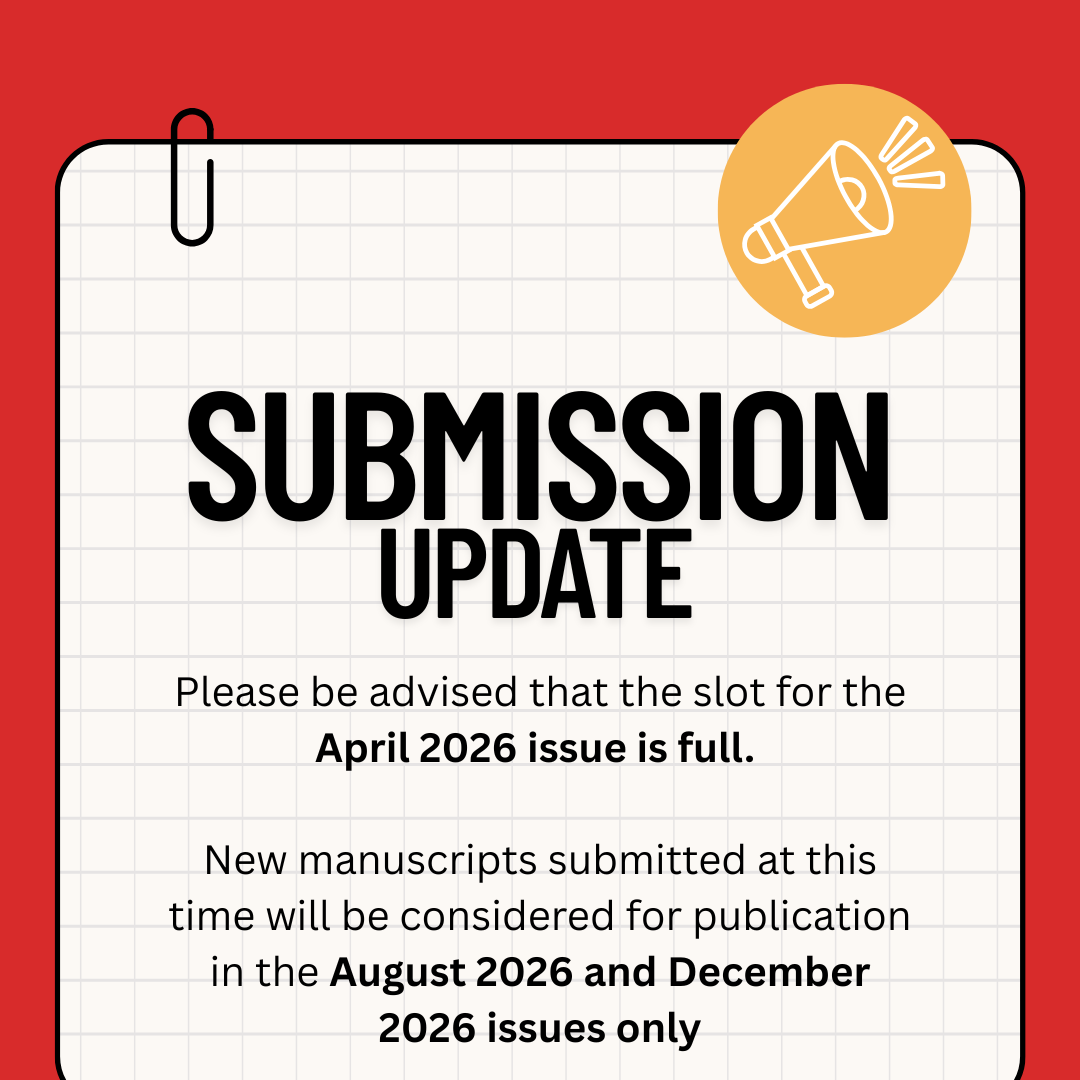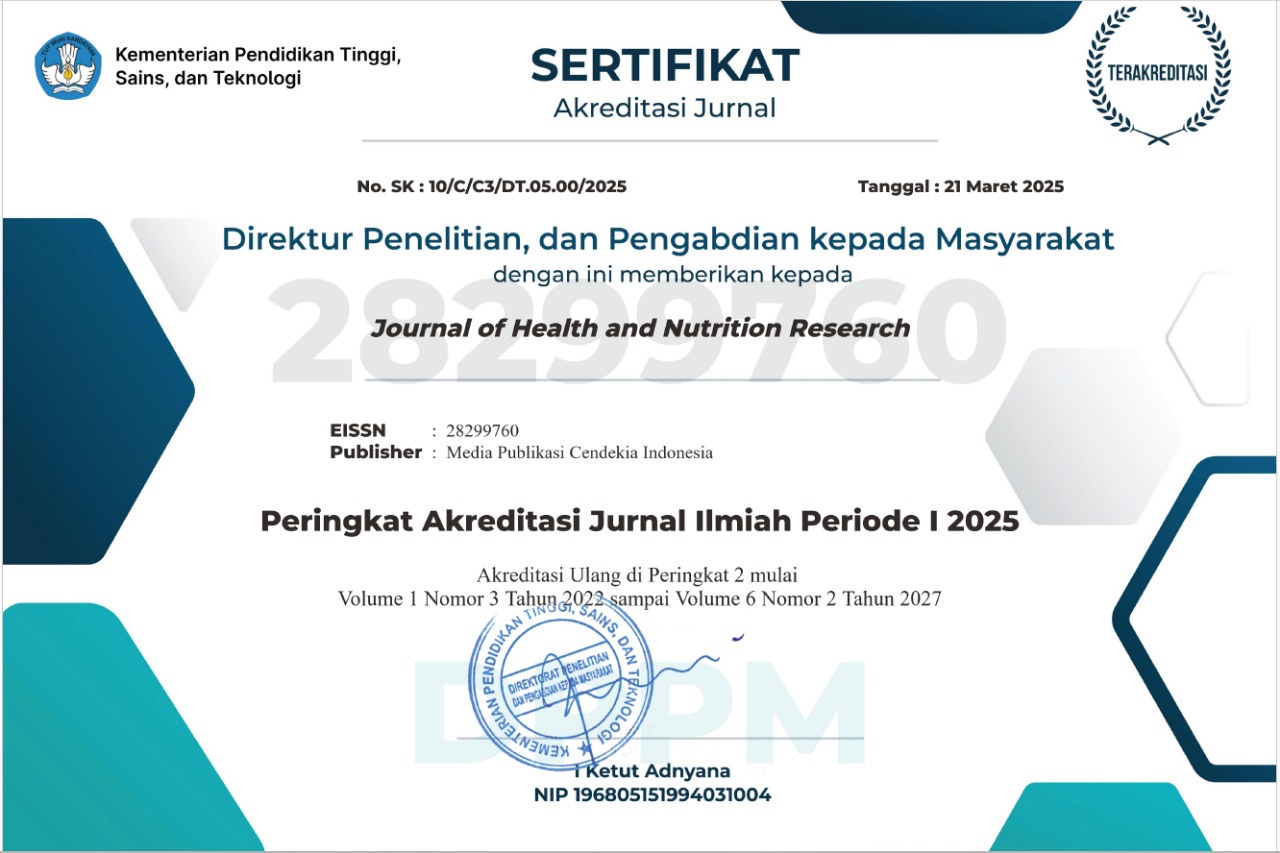The Relationship of Balanced Nutrition Knowledge with the Attitudes and Behaviors of Young Women
Keywords:
Knowledge, Attitude, Behavior, Adolescent Girls, Balance NutritionAbstract
This study aims to determine the relationship between balanced nutrition knowledge with the attitudes and behaviors of adolescent girls. An analytical survey with a cross-sectional design was conducted in July – August 2023 at the Paqusata Youth Integrated Healthcare Center working area of the Teluk Lingga Health Center, East Kalimantan, Indonesia. A total of 51 adolescents were included as a sample using total sampling and setting inclusion and exclusion criteria. Data analysis using the Chi-Square test. Univariate tests showed respondents' age (31.4%), grade 10 (41.2%), mothers with high school education (43.1%), and parents' occupation was IRT (78.4%). Knowledge of balanced nutrition is mostly a good criterion (62.7%), attitudes are mostly good criteria (66.7%), and behaviour is mostly a good criterion (51%). The bivariate test showed knowledge of balanced nutrition with attitudes in adolescent girls with a value of p = 0.000. And knowledge of balanced nutrition with behaviour in adolescent girls with a value of p = 0.025. There is a relationship between knowledge of balanced nutrition and attitudes in adolescent girls. There is a relationship between knowledge of balanced nutrition and behaviour in adolescent girls. It is hoped that the management of the Puskesmas can provide regular nutrition socialization and education at the Adolescent Integrated Healthcare Center and in schools regarding balanced nutrition.
Downloads
References
Mulidah S, Asrin A, Fitriyani A, Subagyo W, Sanjaya S. The Gemas Application Toward Knowledge and Attitude in Preventing Stunting of Teenagers. Malaysian Journal of Medicine and Health Sciences. 2022;18:70–5.
Bhargava M, Bhargava A, Ghate SD, Shyama Prasad Rao R. Nutritional status of Indian adolescents (15-19 years) from National Family Health Surveys 3 and 4: Revised estimates using WHO 2007 Growth reference. PLoS ONE. 2020;15(6 June):1–24.
Sulastri E, Astuti DP. Pendidikan Kesehatan Untuk Meningkatkan Pengetahuan Dan Sikap Remaja Tentang Kesehatan Reproduksi Dan Penyakit Menular Seksual. Jurnal Ilmiah Kesehatan Keperawatan. 2020;16(1):93.
Nankinga O, Aguta D. Determinants of Anemia among women in Uganda: Further analysis of the Uganda demographic and health surveys. BMC Public Health. 2019;19(1):1–9.
Danaei G, Andrews KG, Sudfeld CR, Fink G, McCoy DC, Peet E, et al. Risk Factors for Childhood Stunting in 137 Developing Countries: A Comparative Risk Assessment Analysis at Global, Regional, and Country Levels. PLoS Medicine. 2016;13(11):1–18.
Darling AM, Sunguya B, Ismail A, Manu A, Canavan C, Assefa N, et al. Gender differences in nutritional status, diet and physical activity among adolescents in eight countries in sub-Saharan Africa. Tropical Medicine and International Health. 2020;25(1):33–43.
Abri N, Sirajuddin S, Bahar B, Jafar N, Russeng SS, Zakaria Z, et al. Determinants of Incident Stunting in Elementary School Children in Endemic Area Iodine Deficiency Disorders Enrekang Regency. Open Access Macedonian Journal of Medical Sciences. 2022;10:161–7.
Mutiarasari D, Miranti M, Fitriana Y, Pakaya D, Sari P, Bohari B, et al. A determinant analysis of stunting prevalence on under 5-year-old children to establish stunting management policy. Open Access Macedonian Journal of Medical Sciences. 2021;9:79–84.
Rah JH, Sukotjo S, Badgaiyan N, Cronin AA, Torlesse H. Improved sanitation is associated with reduced child stunting amongst Indonesian children under 3 years of age. Maternal and Child Nutrition. 2020;16(S2):1–8.
Abri N, Zakiah N, Risal AF. The Relationship Between Early Pregnancy, Birth Distance, and Resident Status with Stunting Incidence in Elementary School Children In Enrekang Rural. Journal of Health and Nutrition Research. 2023;2(2):70–8.
Balitbangkes RI. Laporan Riskesdas 2018 Nasional.pdf. Lembaga Penerbit Balitbangkes. 2018.
Kemenkes RI. Survei Status Gizi SSGI 2022. BKPK Kemenkes RI. 2022;1–156.
Quamme SH, Iversen PO. Prevalence of child stunting in Sub-Saharan Africa and its risk factors. Clinical Nutrition Open Science. 2022;42:49–61.
Abdulla F, Rahman A, Hossain MM. Prevalence and risk predictors of childhood stunting in Bangladesh. PLoS ONE. 2023;18(1 January):1–20.
Ponum M, Khan S, Hasan O, Mahmood MT, Abbas A, Iftikhar M, et al. Stunting diagnostic and awareness: Impact assessment study of sociodemographic factors of stunting among school-going children of Pakistan. BMC Pediatrics. 2020;20(1):1–9.
Sathiadas G, Annieston A, Arunath V, Kasthuri T, Wickramasinghe VP. Nutritional status of school children living in Northern part of Sri Lanka. 2020;4–11.
Abri N. Identification of Socio-Demographic Factors with the Incidence of Stunting in Elementary School Children in Rural Enrekang. Journal of Health and Nutrition Research. 2022;1(2):88–94.
Metwally AM, El-Sonbaty MM, El Etreby LA, El-Din EMS, Hamid NA, Hussien HA, et al. Stunting and its determinants among governmental primary school children in Egypt: A school-based cross-sectional study. Open Access Macedonian Journal of Medical Sciences. 2020;8(B):650–7.
Fatemi MJ, Fararouei M, Moravej H, Dianatinasab M. Stunting and its associated factors among 6-7-year-old children in southern Iran: A nested case-control study. Public Health Nutrition. 2019;22(1):55–62.
Beal T, Tumilowicz A, Sutrisna A, Izwardy D, Neufeld LM. A review of child stunting determinants in Indonesia. Maternal and Child Nutrition. 2018;14(4):1–10.
Abri N, Thaha AR, Jafar N. Relationship Between Economic Status, Infectious Diseases and Urinary Iodine Excretion with Stunting Incidence of Elementary School Children in IDD Endemic Areas, Enrekang Regency. Journal of Health and Nutrition Research. 2022;1(3):133–9.
Abri N. Identification of Socio-Demographic Factors with the Incidence of Stunting in Elementary School Children in Rural Enrekang. Journal of Health and Nutrition Research. 2022;1(2):88–94.
Ramdhani A, Handayani H, Setiawan A. Hubungan Pengetahuan Ibu Dengan Kejadian Stunting. Semnas Lppm. 2020;ISBN: 978-:28–35.
Abu-Baker NN, Eyadat AM, Khamaiseh AM. The impact of nutrition education on knowledge, attitude, and practice regarding iron deficiency anemia among female adolescent students in Jordan. Heliyon. 2021;7(2):e06348.
Sumarni YI, Azzahroh P, Suprihatin S. Komunikasi Informasi Edukasi Media Leaflet terhadap Pengetahuan dan Sikap Ibu Hamil Trimester I tentang Pemeriksaan Laboratorium. Jurnal Akademika Baiturrahim Jambi. 2023;12(1):113.
Koca B, Arkan G. The relationship between adolescents’ nutrition literacy and food habits, and affecting factors. Public Health Nutrition. 2020;24(4):717–28.
Dwi Jayanti Y, Elsa Novananda N. Hubungan Pengetahuan Tentang Gizi Seimbang Dengan Status Gizi Pada Remaja Putri Kelas Xi Akuntansi 2 (Di Smk Pgri 2 Kota Kediri). Jurnal Kebidanan. 2019;6(2):100–8.
Sasmita AP, Mubashir A, Vijaya N. Impact of nutritional education on knowledge, attitude and practice regarding anemia among school children in Belgaum, India. Global Health Journal. 2022;6(2):91–4.
Belinda NR, Surya LS. Jurnal Riset Intervensi Pendidikan (JRIP) Media Edukasi Dalam Pendidikan Kesehatan Gigi dan Mulut Pada Anak-Anak. Jurnal Riset Intervensi Pendidikan Vol 3 No 1 Januari 2021. 2021;3(1):58.
Damayanti S, Diah Herawati DM, Syahri A. The Effect of Education Using Video Blog (vlog) On The Female Adolescents’knowledge, Attitudes and Behaviors On The Prevention of Iron Deficiency Anemia (PPAGB) in Bandung. BEST Journal (Biology Education, Sains and Technology). 2021;4(2):221–5.
Herman H, Citrakesumasari C, Hidayanti H, Jafar N, Virani D. Pengaruh Edukasi Gizi Menggunakan Leaflet Kemenkes Terhadap Perilaku Konsumsi Sayur Dan Buah Pada Remaja Di Sma Negeri 10 Makassar. Jurnal Gizi Masyarakat Indonesia: The Journal of Indonesian Community Nutrition. 2020;9(1):39–50.
Wulandari TS, Anisah RL, Fitriana NG, Purnamasari4 I. Pengaruh Pendidikan Kesehatan Dengan Media Leaflet Untuk Meningkatkan Pengetahuan Dan Perilaku Dalam Upaya Menerapkan Protokol Kesehatan Pada Pedagang Di Car Free Day Temanggung. Jurnal Ilmiah Kesehatan. 2020;19(1):9.
Rusdi FY, Helmizar H, Rahmy HA. Pengaruh Edukasi Gizi Menggunakan Instagram Terhadap Perubahan Perilaku Gizi Seimbang Untuk Pencegahan Anemia Pada Remaja Putri Di Sman 2 Padang. Journal of Nutrition College. 2021;10(1):31–8.
Utami RA, Setiawan A, Fitriyani P. Identifying causal risk factors for stunting in children under five years of age in South Jakarta, Indonesia. Enfermeria Clinica. 2019;29:606–11.
Shapu RC, Ismail S, Ahmad N, Lim PY, Njodi IA. Systematic review: Effect of health education intervention on improving knowledge, attitudes and practices of adolescents on malnutrition. Nutrients. 2020;12(8):1–19.
Maharibe CC. Hubungan Pengetahuan Gizi Seimbang Dengan Praktik Gizi Seimbang Mahasiswa Program Studi Pendidikan Dokter Angkatan 2013 Fakultas Kedokteran Universitas Sam Ratulangi. Jurnal e-Biomedik. 2014;2(1).
Published
How to Cite
Issue
Section
Copyright (c) 2024 Nizmah Nizmah, Sepsina Reski, Diah Retno Wahyunigrum, Joko Cahyono

This work is licensed under a Creative Commons Attribution-NonCommercial-ShareAlike 4.0 International License.
Most read articles by the same author(s)
- Naomi Burah, Sepsina Reski, Diah Retno Wahyuningrum, Joko Cahyono, The Effectiveness of Nutrition Education about Stunting Using Video Media on The Knowledge and Attitudes of Mothers of Toddlers , Journal of Health and Nutrition Research: Vol. 3 No. 1 (2024)
- Nanik Sudiyanti, Farida Nailufar, Diah Retno Wahyuningrum, Saraheni Saraheni, The Effect of Infant and Young Child Feeding (IYCF) on the Knowledge and Attitudes of Integrated Healthcare Center Cadres , Journal of Health and Nutrition Research: Vol. 2 No. 3 (2023)



















